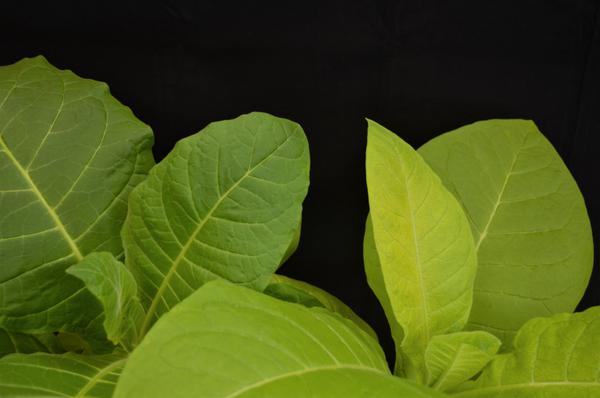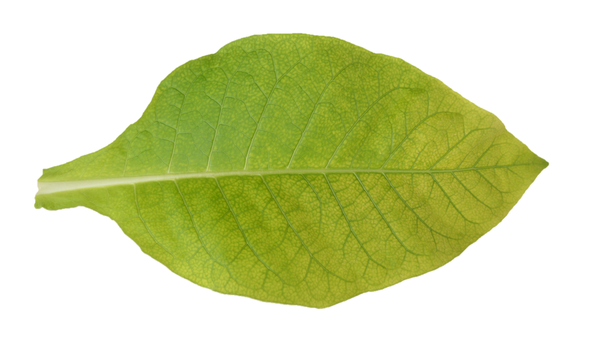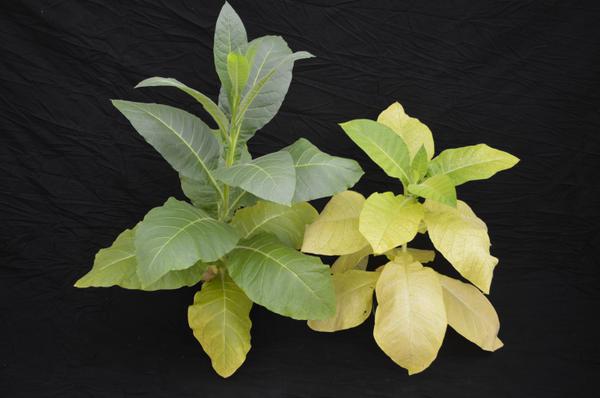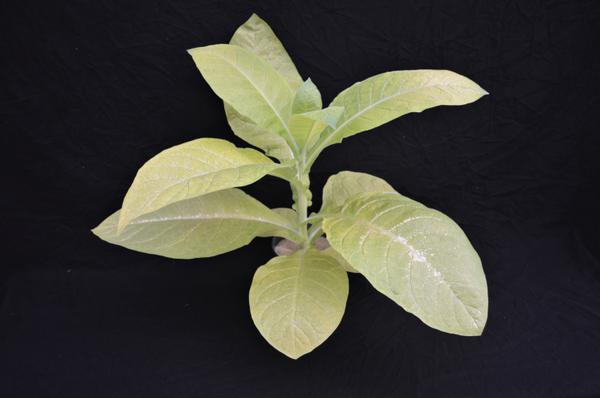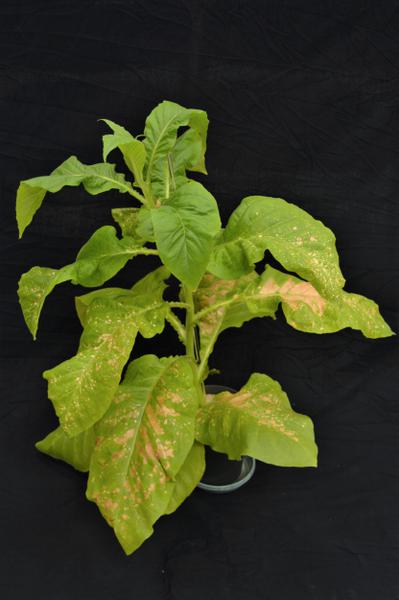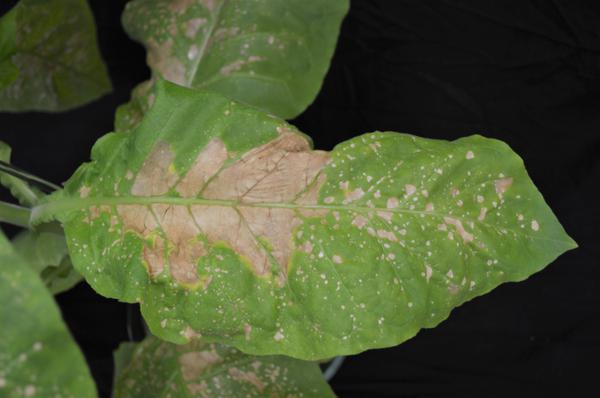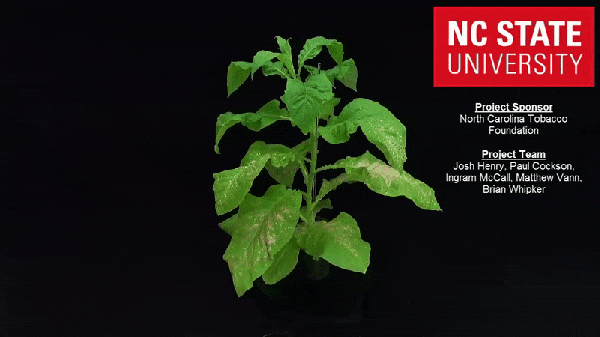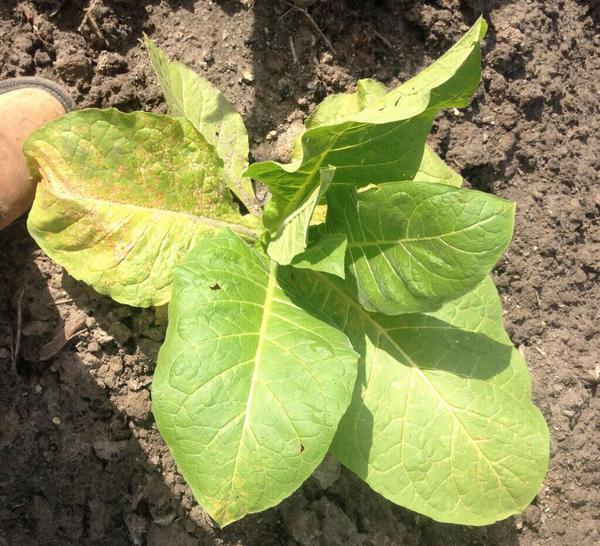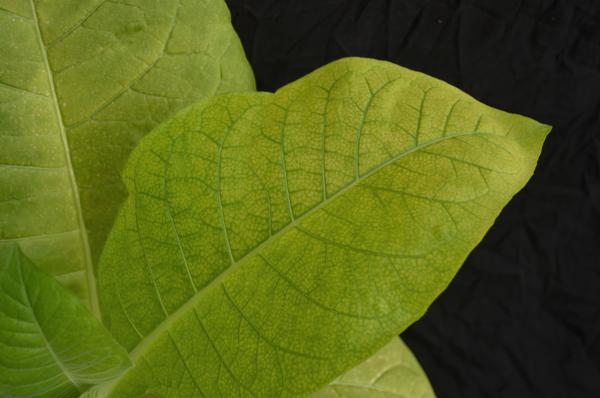Problem
Nutritional disorder – manganese (Mn) deficiency.
Symptoms
Manganese (Mn) deficiency begins as an interveinal chlorosis on the upper leaves (Figure 1). As the symptoms progress, the interveinal chlorosis takes on a pale netted appearance (Figure 2). This symptom will work its way down the plant until it covers the majority of the foliage. Symptomatic plants will start to become stunted when compared to healthy plants (Figure 3). At this point, symptoms begin to diverge between burley and flue cured tobacco.
With advanced symptoms, burley tobacco will start to develop small white spots (Figure 4), but will retain the prominent netted chlorosis observed earlier. The majority of the foliage will also become very pale, with only the youngest leaves remaining green (Figure 5). Flue cured tobacco will also begin to develop white spots, however these spots will quickly grow larger and become much more noticeable than the netted pattern (Figure 6). These large necrotic spots will cover the majority of foliage, and occur primarily surrounding the midrib of the leaf (Figure 7). The spots have a paper-thin texture and will tear very easily, quickly giving symptomatic leaves a ragged appearance. Advanced symptoms may be seen in the 360-degree image below (Figure 8). A plant exhibiting manganese deficiency photographed in the field (Figure 9). Figure 10 shows advanced Mn deficiency.
Similar Problems
Early symptoms strongly resemble weather fleck, which is caused by exposure of plants to high ozone concentrations. These two issues are nearly indistinguishable; therefore, producers should collect tissue and soil samples to assist with correct identification.
Additional Information
Manganese is required in low concentrations, so deficiencies under field conditions can occur, but are uncommon.
Diagnostic Tips
The sufficiency range for manganese is between 20 and 250 ppm for burley tobacco. A slight refinement of the range is available for flue cured tobacco, with 20 and 250 ppm Mn being recommended from planting until maturity. A wider range of 20 to 350 ppm Mn is recommended at harvest for the upper and middle leaves or 18 to 350 ppm manganese for the lower leaves.
Manganese levels greater than 1,000 ppm are considered toxic. This situation usually occurs when the soil pH is low (<5.4).
Corrective Measures
Manganese deficiencies are rare, but can occur when tobacco is grown in soils low in manganese and where pH is 6.2 or higher. These conditions are common to the Coastal Plain where soils have been overlimed to meet the needs of other agronomic crops. Manganese deficiency can be corrected with soil or foliar applications of several Mn fertilizer sources; however, Manganese sulfate appears to be preferable because of application flexibility (foliar or soil) and low cost. Ultimately, to correct manganese deficiency producers should apply 0.5 pounds per acre foliar, three pounds per acre banded, or 10 pounds per acre broadcast.
Management
Provide manganese with your fertilization program. Manganese will be provided in sufficient quantity with N-P-K fertilizer sources blended for tobacco. If producers are not using N-P-K sources and have transitioned to prescription based fertility programs, then it is best to only apply manganese if needed. Additional manganese is not typically required when soil pH is below 6.2.
Funding Source
Funding was provided in part by the North Carolina Tobacco Foundation.
Project Team
Josh Henry (NC State M.S. student in Horticultural Science), Paul Cockson (NC State B.S. student in Agroecology), Ingram McCall (Research Technician in Horticultural Science), Rhonda Conlon and Rob Ladd (Extension IT at NC State), Matthew Vann (Tobacco Extension Specialist, Dept. of Crop and Soil Sciences), and Brian Whipker (Professor of Floriculture and Plant Nutrition in Horticultural Science).
Publication date: Jan. 1, 2017
NC Cooperative Extension prohíbe la discriminación por raza, color, nacionalidad, edad, sexo (incluyendo el embarazo), discapacidad, religión, orientación sexual, identidad de género, información genética, afiliación política, y estatus de veteran.
The use of brand names in this publication does not imply endorsement by NC State University or N.C. A&T State University of the products or services named nor discrimination against similar products or services not mentioned.
Recommendations for the use of agricultural chemicals are included in this publication as a convenience to the reader. The use of brand names and any mention or listing of commercial products or services in this publication does not imply endorsement by NC State University or N.C. A&T State University nor discrimination against similar products or services not mentioned. Individuals who use agricultural chemicals are responsible for ensuring that the intended use complies with current regulations and conforms to the product label. Be sure to obtain current information about usage regulations and examine a current product label before applying any chemical. For assistance, contact your local N.C. Cooperative Extension county center.
N.C. Cooperative Extension prohibits discrimination and harassment regardless of age, color, disability, family and marital status, gender identity, national origin, political beliefs, race, religion, sex (including pregnancy), sexual orientation and veteran status.

